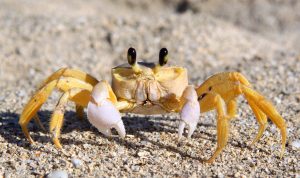 According to the Georgia Institute of Technology, crab shells and trees may soon replace the flexible plastic packaging used to keep food fresh. The innovative process involves spraying multiple layers of chitin from crab shells and cellulose from trees to form a flexible film similar to plastic packaging film. Once fully dried, the material is flexible, strong, transparent, and compostable.
According to the Georgia Institute of Technology, crab shells and trees may soon replace the flexible plastic packaging used to keep food fresh. The innovative process involves spraying multiple layers of chitin from crab shells and cellulose from trees to form a flexible film similar to plastic packaging film. Once fully dried, the material is flexible, strong, transparent, and compostable.
Not only will these lifeforms become a source of sustainable and renewable wrapping, but they will also help improve food quality. Compared to conventional plastic packaging, the new technology offers a 67 percent reduction in oxygen permeability, allowing food to stay fresh even longer.
J. Carson Meredith, a professor in Georgia Tech’s School of Chemical and Biomolecular Engineering, says as the population continues to grow it is important to make food packaging sustainable.
Environmentalists have long looked for renewable ways to replace petroleum-based materials, found in the transparent packaging seen in vending machines, soft drink bottles, and other consumer products. With the amount of cellulose already produced and a ready supply of chitin-rich byproducts left over from the shellfish food industry, there’s likely more than enough material available to make the new films a viable flexible-packaging alternative, says Meredith.
Still, the logistics and kinks of the process need to be resolved. For example, the manufacturing process on a massive scale needs to be implemented in a way that is economical. In addition, certain parts of the process still need to be worked on for mass production. More research needed to improve the material’s ability to block water vapor.
Visit us at AiMES 2018 in Cancun, Mexico from September 30 – October 4, 2018 for presentations on sustainable chemistry and engineering.


